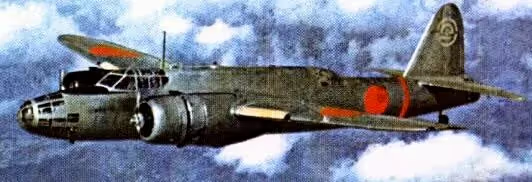Warplanes of Japan: Nakajima Ki-49 Donryu
Nakajima Ki-49 Donryu

(IJAAF Photo)
The Nakajima Ki-49 Donryu (呑龍, "Storm Dragon") was a twin-engine Japanese Second World War heavy bomber. It was designed to carry out daylight bombing missions, without the protection of escort fighters. Consequently, while its official designation, Army Type 100 Heavy Bomber, was accurate in regard to its formidable defensive armament and armor, these features restricted the Ki-49 to payloads comparable to those of lighter medium bombers – the initial production variant could carry only 1,000 kg (2,200 lb) of bombs.A mid-wing, cantilever monoplane of all-metal construction, the Ki-49 was one of the first Japanese aircraft fitted with a retractable tailwheel. During the Second World War, it was known to the Allies by the reporting name "Helen".
The Ki-49 was designed to replace the Mitsubishi Ki-21 ("Sally"), which entered service with the Imperial Japanese Army Air Force in 1938.[2] Learning from service trials of the Ki-21, the Army realized that however advanced it may have been at the time of its introduction, its new Mitsubishi bomber would in due course be unable to operate without fighter escorts. The Japanese Army stipulated that its replacement should have the speed and defensive weaponry to enable it to operate independently.The prototype first flew in August 1939 and the development programme continued through three prototypes and seven pre-production aircraft. This first prototype was powered by a pair of 708 kW (949 hp) Nakajima Ha-5 KA-I radial engines but the next two had the 932 kW (1,250 hp) Nakajima Ha-41 engines that were intended for the production version. Seven more prototypes were built and these completed the test programme for the aircraft. Eventually in March 1941, the Donryu went into production as the Army Type 100 Heavy Bomber Model 1. (Wikipedia)
Going operational from autumn 1941, the Ki-49 first saw service in China. After the outbreak of the Pacific War it was also active in the New Guinea area and in raids on Australia. Like the prototype, these early versions were armed with five 7.7 mm (0.303 in) machine guns and one 20 mm (0.787 in) cannon. Combat experience in China and New Guinea showed the Donryu to be underpowered, with bomb capacity and speed suffering as a result. Thus, in the spring of 1942 an up-engined version was produced, fitted with more powerful Ha-109 engines and this became the production Army Type 100 Heavy Bomber Model 2 or Ki-49-IIa. The Model 2 also introduced improved armor and self-sealing fuel tanks and was followed by the Ki-49-IIb in which 12.7 mm (0.5 in) Ho-103 machine guns replaced three of the 7.7 mm (0.303 in) Type 89 machine guns.
In spite of these improvements, losses continued to mount as the quantity and quality of fighter opposition rose. In early 1943 further power increases were delayed owing to development difficulties with the 1,805 kW (2,421 hp) Nakajima Ha-117 engines and the Ki-49-III never entered production with only six prototypes being built.In the face of its increasing vulnerability to opposing fighter aircraft while performing its intended role, the Ki-49 was used in other roles towards the end of the Pacific War, including anti-submarine warfare patrol, troop transport and as a kamikaze. After 819 aircraft had been completed, production ended in December 1944.[7] 50 of these were built by Tachikawa. (Wikipedia)
















(IJAAF Photos)
Nakajima Ki-49 Donryu (Storm Dragon), codenamed Helen, in IJAAF service.

(USAAF Photo)
Nakajima Ki-49 Donryu (Storm Dragon), codenamed Helen, in IJAAF service and with green surrender crosses. Three Ki-49 Donryu were brought to the USA for flight testing. Ki-49 USAAF FE-1703 and FE-1704 were scrapped at Middletown, and FE-1705 was scrapped at Newark.

(IWM Photo, C779)
British troops inspect captured Ki-49s at Kalidjati airfield, Java c. 1945.

(National Archives of Japan Photo)
Wreck of a Nakajima Ki-49 Donryu, possibly somewhere in the South Pacific, 1941-1945.



(Acred99 Photos 1-3)
Nakajima Ki-49 Hellen, wreck on Papua New Guinea.





